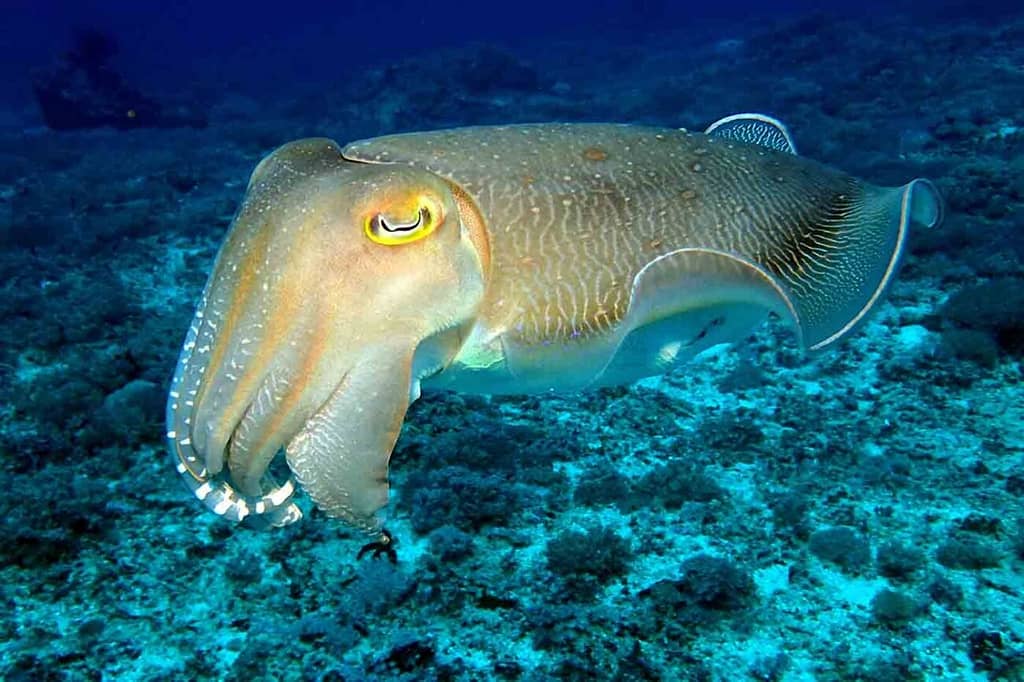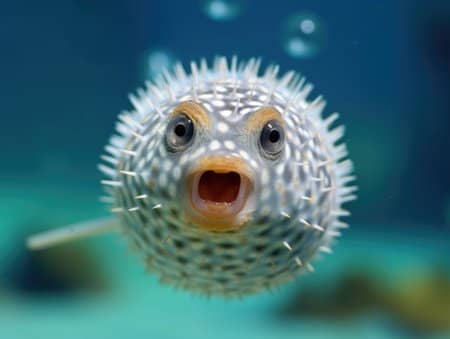The animal kingdom is a treasure trove of peculiar and fascinating behaviors that often escape our notice. While some animals display the expected behaviors associated with their species, others exhibit habits that are truly out of the ordinary. These quirky behaviors can range from astonishing feats of intelligence to bizarre reproductive strategies and everything in between.
Cuttlefish

Cuttlefish are cephalopods known for their incredible ability to change the color and texture of their skin. They use this remarkable skill not only for camouflage but also for communication. When two cuttlefish meet, they engage in dynamic displays of color patterns, which can convey messages related to courtship, aggression, or warning signals. What’s particularly astonishing is that cuttlefish can communicate using this sophisticated visual language even in total darkness or when their vision is impaired. This makes them masters of non-verbal communication, using their skin as a canvas to express a wide range of emotions and intentions.
Sloths

Sloths are famous for their incredibly slow movements and their peculiar bathroom habits. These arboreal creatures, found in Central and South America, descend from their treetop homes about once a week to defecate. What sets them apart is their meticulous approach to this task. They dig a small hole in the ground, defecate in it, and then cover it up. This behavior minimizes the sloth’s exposure to ground-level predators while also recycling nutrients back into the ecosystem. The sloth’s infrequent bathroom visits and careful burial of feces are fascinating adaptations to their slow-paced, tree-dwelling lifestyle.
Pufferfish

Some species of male pufferfish, found in Japan, create intricate underwater patterns on the ocean floor to attract potential mates. These patterns, known as “crop circles,” are formed by the pufferfish using their fins to push sand and other debris into radial ridges. The purpose of these impressive displays is to impress female pufferfish, who will inspect the circles and choose a mate based on the quality of his creation. This behavior showcases the extent to which animals can go to attract a partner and demonstrates the diverse ways in which creatures in the animal kingdom express their creativity and courtship rituals.
Dolphins
In Shark Bay, Australia, bottlenose dolphins have been observed using sponges as tools while foraging. They wear these sponges over their snouts, protecting them from abrasions and stings when rooting around on the seafloor for food. This behavior is a remarkable example of tool use in non-human animals, as these dolphins have learned to adapt and innovate in their environment. It also highlights their problem-solving abilities and capacity to transmit cultural knowledge across generations, as only certain groups of dolphins in this region exhibit this behavior. The use of sponges as a form of protective tool is a striking demonstration of the resourcefulness and adaptability of marine mammals.
Dung Rolling Beetles

Dung beetles, particularly those in the African savannah, have an intriguing habit of using the Milky Way for navigation. They roll balls of dung, sometimes much larger than themselves, to bury underground and use as a food source or a breeding chamber. To avoid getting lost during their journey, these beetles have evolved the ability to detect the polarization pattern of moonlight, which allows them to navigate in a straight line. When the moon is not visible, they rely on the Milky Way for orientation. This celestial navigation ability is a remarkable example of how even tiny insects have developed specialized adaptations to survive and thrive in their environments.
Self-Medicating Monkeys

Capuchin monkeys, found in Central and South America, have been observed engaging in an unusual behavior involving millipedes. These monkeys intentionally rub millipedes on their fur, causing the millipedes to release a toxic chemical. This might seem counterintuitive, but the behavior is thought to act as a natural insect repellent. The toxic substance from the millipedes helps keep insects and parasites away from the monkeys. It’s a fascinating example of animals not only adapting to their environment but also utilizing seemingly harmful elements for their own benefit.
Cephalopod Intelligence
Octopuses are renowned for their exceptional intelligence among invertebrates. They possess problem-solving skills, memory, and the ability to learn through observation. Octopuses can solve complex puzzles, manipulate objects, and even escape from enclosures. What’s even more astonishing is their unmatched mastery of camouflage. They can rapidly change the color, texture, and shape of their skin to blend seamlessly with their surroundings or mimic other marine creatures. This camouflage not only serves as a defense mechanism but also allows octopuses to hunt prey effectively and avoid predators. Their advanced cognitive abilities and remarkable adaptability make cephalopods, including octopuses, some of the most intriguing creatures in the ocean.
Fireflies
Fireflies in certain regions display a mesmerizing behavior known as “synchronous flashing.” Large groups of fireflies gather and flash their bioluminescent lights in unison, creating spectacular light shows in the night sky. The exact reason behind this synchronized behavior is not entirely understood, but it is believed to be related to mating. Male fireflies emit specific light patterns, and females respond with synchronized flashes. This synchronization may help fireflies find suitable mates. The phenomenon is a testament to the intricacies of communication and coordination in the animal kingdom, where even small insects can create stunning displays of synchronized light.
Bowerbird

Male bowerbirds, found in Australia, are renowned for their artistic courtship behavior. To attract females, they construct elaborate bowers, which are essentially carefully designed structures made from twigs, grass, and other materials. What sets them apart is their sense of aesthetics. Male bowerbirds adorn their bowers with an assortment of colorful objects like flowers, feathers, and even bits of plastic, creating visually stunning displays. The quality and creativity of their bowers play a significant role in attracting potential mates. This behavior showcases the incredible lengths to which some animals go to impress their partners and highlights the importance of aesthetics in the animal world.
Honeybee

Honeybees have developed a unique way of communicating the location of food sources to other members of the hive. This communication is known as the “waggle dance.” When a forager bee returns to the hive after finding a food source, it performs a dance that conveys information about the direction and distance to the food. By waggling their bodies and making specific movements on the honeycomb, they inform their fellow bees about the exact location of nectar or pollen. This sophisticated form of communication helps the colony efficiently allocate its foraging efforts, ensuring a steady supply of resources. The waggle dance is a remarkable example of how honeybees have evolved intricate social behaviors to enhance their survival and productivity.
Leaf-Cutter Ants

Leaf-cutter ants, found in Central and South America, have a remarkable division of labor within their colonies. They are known for cutting and carrying leaf fragments back to their underground nests. However, what’s intriguing is that they don’t eat the leaves; instead, they use them to cultivate a special fungus. The ants feed on the fungus, which breaks down the leaves and converts them into a more digestible form. This farming behavior is an excellent example of how insects have evolved complex symbiotic relationships with other organisms and engage in agriculture-like practices, albeit on a miniature scale.
Nudibranchs

Nudibranchs are a diverse group of colorful, sea-dwelling slugs found worldwide. They are renowned for their dazzling and intricate external appearances, which serve as a defense mechanism. Many species of nudibranchs incorporate toxins from their prey into their own tissues, making them toxic or distasteful to potential predators. Their vibrant colors and patterns serve as a warning to would-be attackers, showcasing a unique example of chemical defense and visual communication in the animal kingdom.
Surinam Toad

The Surinam toad, native to South America, has a distinctive reproduction method. Females carry their fertilized eggs on their backs, embedded within skin pockets. The eggs develop into tadpoles beneath the skin, eventually emerging as fully developed toads. This process, known as “dermal brooding,” is highly unusual and has captivated researchers and enthusiasts for its extraordinary adaptation for parental care and protection.
Narwhal

The narwhal, often called the “unicorns of the sea,” is a marine mammal with a long, spiral tusk that can reach lengths of up to 10 feet (3 meters). While the tusk is typically associated with males and is used for various functions, including mating displays and breaking ice, some females and a small percentage of males also have tusks. The exact purpose of the narwhal’s tusk remains a subject of scientific inquiry and adds an element of mystery to this Arctic-dwelling creature.
These animals demonstrate the incredible diversity of behaviors and adaptations found in the animal kingdom, highlighting the fascinating ways in which creatures have evolved to survive and thrive in their respective environments.
